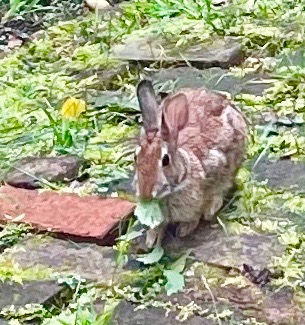
Thursday, September 16
Lucky is back!
Or at least a relative of Lucky’s is. The much-missed rabbit–last seen in June of 2020–appeared on Tuesday, happily chomping on the weeds that sprout between the bricks on our patio, just like old times.
The post-Labor Day withering away of the East End’s human population has encouraged all sorts of wildlife to re-consider their relationship with our yard. A deer family of a mom and two very little ones visits every day. Another returning visitor is a chipmunk that we’ve dubbed Thelonious in honor of another Monk, the legendary jazz pianist. (Thelonious feasts on the shells of birdseed that the avian visitors have spilled under their feeder.) Then there are the squads of birds who come to our feeder and two bird baths. Some of these particularly enjoy the latter, both as a place to drink and really scrub their feathers.
The early fall months generally bring lots of birds to the area, perhaps as they prepare to migrate. Geese fly over in V-shaped formations, and hoardes of blackbirds circle, squawk, bicker, and peck at the ground. Even the squirrels are somewhat intimidated.
Yesterday I was able to strike off another item from my to-do list: I got a new battery for my Mac laptop, just as the machine had been urging me to do for weeks. This was not so easy. I had to take the computer to a shop in Sag Harbor and leave it there for several days as they replaced both battery and the attached keyboard. After retrieving the computer, Emily and I went to an admired Water Mill farm stand to get cantaloupe, corn, winter squash, lettuce, tomatoes, and apples–all stuff that’s simply more authentic and tasty when it comes from farm stands rather than the supermarket.
I’ve been reading Danish poet Tove Ditlevsen’s memoirs, The Copenhagen Trilogy. (Nordic noir videos have encouraged an interest in Scandinavia.) Much of the book is an account of her struggle to get published and win recognition as a writer. But she also describes her romantic relationships with a number of guys…and her three pregnancies, two of which ended with abortions. The events described take place in the late 1930s and 1940s, a period that includes the Nazi occupation of her homeland.
Of course, I’m reading Ditlevsen’s description of unwanted pregnancies and abortions during a fraught period in the United States, when state legislators and courts are making it ever more difficult to get an abortion. Abortion was illegal in Denmark during Ditlevsen’s lifetime. Why? The religious establishment? A general sense that life was sacred–and that the sexually active should be punished? A sense that women are evil and unclean and get what they deserve? The more you ponder it, the more mysterious the matter becomes.
The New York Times yesterday published a very insightful opinion piece on the history of the abortion-rights struggle in the U.S. According to Thomas B. Edsall, back in the 1970s and ’80s, the majority of Republicans and conservatives were no more stridently anti-abortion than other Americans. But a handful of conservative activists changed that. After a “long and contentious debate,” the likes of Phyllis Schlafly, Richard Viguerie, and Jerry Falwell abandoned the issue that had first drawn them into political activism–the desire to defend the tax advantages of religious, whites-only schools. Instead, they settled on a concerted effort to politicize abortion in part because “it dodged the race issue and offered the opportunity to unify conservative Catholics and Evangelicals.” Anti-abortion politics, they found, provided a chance to attract a mass base to their otherwise flakey, beyond-the-fringe politics.
Dinner: Blistered broccoli pasta with walnuts, cheese, and herbs plus a lettuce and avocado salad.
Entertainment: the often-imitated Swedish/Danish version of policier The Bridge, season three.
